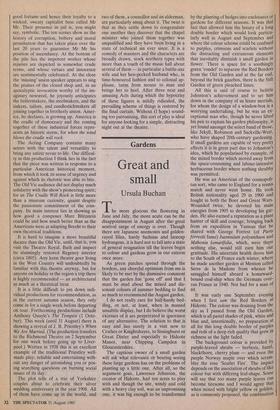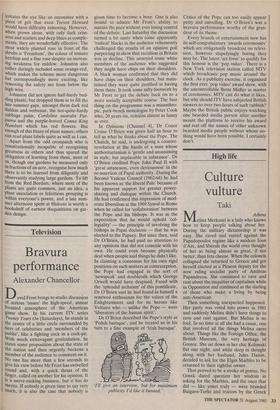Gardens
Great and small
Ursula Buchan
The more glorious the flowering in June and July, the more acute can be the disappointment in August after the great aestival surge of energy is. over. Though there are Japanese anemones and golden- rayed lilies, hardy fuchsias and lacecap hydrangeas, it is hard not to fall into a state of general resignation till the leaves begin to colour and gardens grow in our esteem once more.
As green patches spread through the borders, any cheerful optimism from me is likely to be met by the dismissive comment that the garden has 'gone off' and that I must be mad about the mixed and dis- sonant colours of summer bedding to find so much to recommend the August garden.
I do not really care for half-hardy bed- ding, or not, at least, when in massed unsubtle display, but I do believe the worst excesses of it are perpetrated in ignorance of any alternative. The solution to that is easy and lies surely in a visit now to Crathes or Knightshayes, to Sissinghurst or Great Dixter and especially to Hidcote Manor, near Chipping Campden in Gloucestershire.
The captious owner of a small garden will ask what relevance or bearing seeing these large gardens has on the problems of planting up a little one. After all, so the argument goes, Lawrence Johnston, the creator of Hidcote, had ten acres to play with and though the site, windy and cold with a heavy clay soil, was an unpromising one, it was big enough to be transformed by the planting of hedges into enclosures or gardens for different seasons. It was that fact that allowed him the luxury of a long double border which would look particu- larly well in August and September and where the colour scheme could be confined to purples, crimsons and starlets without the distracting and • extraneous elements that inevitably diminish a small garden in flower. There is space for a soothingly green `ronder to separate the Red Borders from the Old Garden and at the far end, beyond the brick gazebos, there is the Stilt Garden of green pleached limes.
All this is said of course to belittle Johnston's achievement and to set him down in the company of us lesser mortals, for whom the design of a window-box is a worrying undertaking, but he was an ex- ceptional man who, though he never lifted his pen to explain his garden philosophy, is yet found amongst the select band of those, like Jekyll, Robinson and Sackville-West, who have shaped 20th-century gardening. If small gardens are capable of very pretty effects it is in great part due to Johnston's idea, which he popularised by example, of the mixed border which moved away from the space-consuming and labour-intensive herbaceous border where nothing shrubby was permitted.
He was an American of the cosmopoli- tan sort, who came to England for a tennis match and never went home. He took British nationality aged 29 in 1900 and fought in both the Boer and Great Wars. Wounded twice, he devoted his main energies from 1905 to developing his gar- den. He also earned a reputation as a plant hunter of skill and courage, bringing back from an expedition in Yunnan that he shared with George Forrest (of Pieris forrestii fame) Jasminium polyanthum and Mahonia lomarifolia, which, were there nothing else, would still earn him our gratitude. His uncertain health drove him to the South of France each winter, where he made another garden at Menton called Serre de la Madone from whence he smuggled himself aboard a homeward- bound coal-ship when the Germans over- ran France in 1940. Not bad for a man of 69.
It was early one September evening when I first saw the Red Borders at Hidcote. The colour was draining from the sky as I passed from the Old Garden, which is all pastel shades of pink, white and blue and, intentionally, no preparation at all for this long double border of purples and reds of a deep rich quality that grew in richness as the light faded. The background colour is provided by purple-leaved shrubs — berberis, hazel, blackthorn, cherry plum — and even the purple Norway maple over which scram- bles the rose 'Scarlet Fire'. The impact depends on the association of shrubs of like colour but with differing leaf-shape. Some will say that too many purple leaves can become tiresome and I would agree that when mixed with bright yellow or golden, as is commonly proposed, the combination irritates the eye like an encounter with a piece of grit that even Trevor Howard would have difficulty removing. However, when grown alone, with only dark crim- sons and starlets and deep blues as comple- ments, they are wonderfully effective. The most widely planted rose in front of the shrubs is 'Frensham', the colour of tomato ketchup and a fine rose despite an increas- ing weakness for mildew. Johnston also rather daringly included some orange-red, which makes the scheme more dangerous but correspondingly more exciting, like removing the safety net from below the high wire.
Johnston did not ignore half-hardy bed- ding plants, but dropped them in to fill the late summer gaps, amongst them dark red dahlias and verbenas, the not-quite-hardy cabbage palm, Cordyline australis Pur- purea and the purple-leaved Canna King Humbert which has red flowers. But enough of this litany of plant names; others Can read plant labels quite as well as I can.
Apart from the odd crosspatch who is constitutionally incapable of recognising greatness in others and thus spared the obligation of learning from them, most of us, though our gardens be measured only in fractions of an acre, recognise how much there is to be learned from diligently and observantly studying large gardens. To lift from the Red Borders, where most of the plants are quite common, just an idea, a plant association or felicitious grouping is within everyone's power, and a late sum- mer afternoon spent at Hidcote is worth a bookshelf of earnest disquisitions on gar- den design.











































 Previous page
Previous page